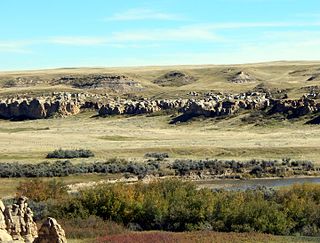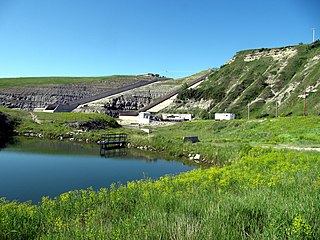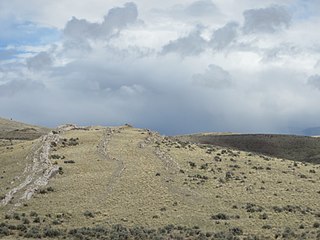| Billman Creek Formation Stratigraphic range: Maastrichtian | |
|---|---|
| Type | Geological formation |
| Unit of | Livingston Group |
| Underlies | Hoppers Formation |
| Overlies | Miner Creek Formation |
| Location | |
| Region | Montana |
| Country | United States of America |
The Billman Creek Formation is a Mesozoic geologic formation in south-central Montana. [1] Dinosaur remains are among the fossils that have been recovered from the formation, although none have yet been referred to a specific genus. [2]
The Billman Creek Formation is a unit of the Livingston Group. [3]

The Lance (Creek) Formation is a division of Late Cretaceous rocks in the western United States. Named after Lance Creek, Wyoming, the microvertebrate fossils and dinosaurs represent important components of the latest Mesozoic vertebrate faunas. The Lance Formation is Late Maastrichtian in age, and shares much fauna with the Hell Creek Formation of Montana and North Dakota, the Frenchman Formation of southwest Saskatchewan, and the lower part of the Scollard Formation of Alberta.

The Scollard Formation is an Upper Cretaceous to lower Palaeocene stratigraphic unit of the Western Canada Sedimentary Basin in southwestern Alberta. Its deposition spanned the time interval from latest Cretaceous to early Paleocene, and it includes sediments that were deposited before, during, and after the Cretaceous-Paleogene (K-Pg) extinction event. It is significant for its fossil record, and it includes the economically important coal deposits of the Ardley coal zone.

The Laramie Formation is a geologic formation of Late Cretaceous (Maastrichtian) age, named by Clarence King in 1876 for exposures in northeastern Colorado, in the United States. It was deposited on a coastal plain and in coastal swamps that flanked the Western Interior Seaway. It contains coal, clay and uranium deposits, as well as plant and animal fossils, including dinosaur remains.

The Cloverly Formation is a geological formation of Early Cretaceous age that is present in parts of Montana, Wyoming, Colorado and Utah in the western United States. It was named for a post office on the eastern side of the Bighorn Basin in Wyoming by N.H. Darton in 1904. The sedimentary rocks of formation were deposited in floodplain environments and contain vertebrate fossils, including a diverse assemblage of dinosaur remains. In 1973, the Cloverly Formation Site was designated as a National Natural Landmark by the National Park Service.

The Foremost Formation is a stratigraphic unit of Late Cretaceous (Campanian) age that underlies much of southern Alberta, Canada. It was named for outcrops in Chin Coulee near the town of Foremost and is known primarily for its dinosaur remains and other fossils.

The St. Mary River Formation is a geologic formation of Late Cretaceous age of the Western Canada Sedimentary Basin in southwestern Alberta and northwesternmost Montana. It was first described from outcrops along the St. Mary River by George Mercer Dawson in 1883, and it takes its name from the river.
The Livingston Group is a geological formation in Montana whose strata date back to the Late Cretaceous. Dinosaur remains are among the fossils that have been recovered from the formation.

The Arapahoe Formation is a geological formation of latest Cretaceous (Maastrichtian) age that is present within the Denver Basin that underlies the Denver, Colorado, area. The formation includes fossil leaves and dinosaur remains, although none of the latter have yet been referred to a specific genus. It also includes aquifers that are important sources of water for the area.
The Cokedale Formation is a Mesozoic geologic formation in the United States. Dinosaur remains are among the fossils that have been recovered from the formation, although none have yet been referred to a specific genus.
The Horsethief Sandstone is a Mesozoic geologic formation in Montana. Dinosaur remains are among the fossils that have been recovered from the formation, although none have yet been referred to a specific genus. The southern part of the Two Medicine Formation grades into the brackish water siltstone/sandstone series that compose the Horsethief Formation. To the north the Horsethief Sandstone is equivalent to the Blood Reserve Formation of Alberta, Canada.
The Iljig Formation is a Lower Cretaceous geologic formation in South Korea. Dinosaur remains are among the fossils that have been recovered from the formation, although none have yet been referred to a specific genus.

The Kootenai Formation is a Lower Cretaceous geologic formation. The Kootenai was deposited in a foreland basin east of the Sevier thrust belt in western Montana. The lithology consists of a basal conglomerate with overlying non-marine sandstones, shales and lacustrine limestones.

The Moenave Formation is a Mesozoic geologic formation, in the Glen Canyon Group. It is found in Utah and Arizona.

The Pictured Cliffs Formation is a Campanian geologic formation in the San Juan Basin of New Mexico. Dinosaur remains are among the fossils that have been recovered from the formation, although none have yet been referred to a specific genus.

The Point Lookout Sandstone is a Cretaceous bedrock formation occurring in New Mexico and Colorado.
The Telegraph Creek Formation is a Mesozoic geologic formation in Montana, United States. Dinosaur remains are among the fossils that have been recovered from the formation, although none have yet been referred to a specific genus.

The Mowry Shale is a Late Cretaceous geologic formation. The formation was named for Mowrie Creek, northwest of Buffalo in Johnson County, Wyoming. The Mowry crops out or occurs at depth in parts of Colorado, Montana, North Dakota, South Dakota, Utah and Wyoming. It occurs within the following geologic regions:

The Lossiemouth Sandstone is a Middle to Late Triassic age geological formation. It is exposed on the south side of the Moray Firth near Lossiemouth and near Golspie in Sutherland. Dinosaur remains are among the fossils that have been recovered from the formation.
The Minnes Group, originally named the Minnes Formation, is a geologic unit of latest Jurassic to earliest Cretaceous age in the Western Canada Sedimentary Basin. It is present in the northern foothills of the Canadian Rockies and the adjacent plains in northeastern British Columbia and west-central Alberta. Its strata include natural gas reservoirs and minor coal deposits. Fossil dinosaur tracks have been described from one of its formations.

The Mesaverde Group is a Late Cretaceous stratigraphic group found in areas of Colorado, New Mexico, Utah, and Wyoming, in the Western United States.
| | This article about a specific stratigraphic formation in the United States is a stub. You can help Wikipedia by expanding it. |